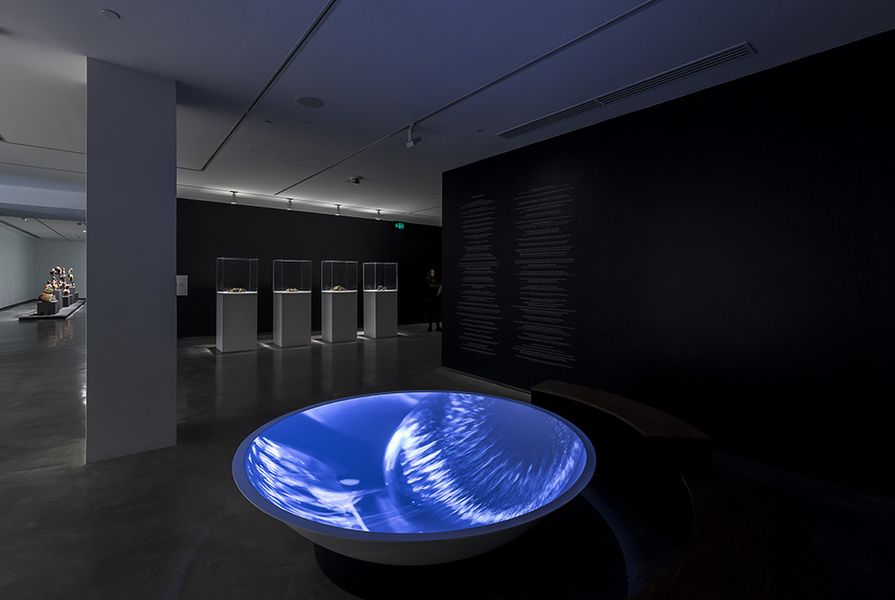The 21st Biennale of Sydney is presenting the work of seventy local and international artists over a three month period from March to June this year. Exploring the theme of ‘SUPERPOSITION: Equilibrium & Engagement’ in 2018, artists from six continents including Africa, Asia, Australia, North and South America, Europe and Australia are exhibiting their work across seven Sydney venues, from the Art Gallery of NSW to Cockatoo Island, the Museum of Contemporary Art and the 4A Centre for Contemporary Asian Art.
Landscape Australia selects some highlights from the 2018 program:

Anya Gallaccio, Beautiful Minds, 2015–17, aluminium, clay, pump, computer, software, 5 x 5 x 5 m. Courtesy the artist; Thomas Dane Gallery, London; and Blum & Poe, Los Angeles.
Image: Luke Walker
Anya Gallaccio creates ephemeral, site-specific installations that provide vivid, sensorial experiences of the natural processes of transformation and decay. In Beautiful Minds, 2015–18, Gallaccio explores the idea of technology rather than nature serving as the self-determining force. Within the Industrial Precinct at Cockatoo Island, Gallaccio has installed a giant 3D printer loaded with clay that creates a scale-model of an existing mountainscape – Devil’s Tower, in Wyoming, USA. Building up the sedimentary ‘rock’ layer by layer, the machine accelerates a geological process that usually takes millions of years. By drawing attention to the mechanised process as a form of drawing rather than sculpture-making, Gallaccio prompts a rethinking of our understanding of natural processes in light of technological advancements.
Yasmin Smith at Cockatoo Island
Yasmin Smith works within the parameters of ceramics, creating site-specific installations driven by extensive research. Merging aspects of art, archaeology and science, she examines the processes and chemical composition of glazes made from material found on site to reveal the history, ecology, geology and culture of a place. Drowned River Valley, 2018, marks the border between the salty waters of Sydney Harbour and the less saline waters of the Parramatta River system. Presented at two separate locations on Cockatoo Island, the work examines the local presence of salt harvested from harbour/river tidal exchange water around the Island as well as in the ash of Avicennia marina (grey mangrove). At the south end of Cockatoo Island, Smith has created a functioning studio with an outdoor kiln and salt farm where the visiting public can contribute their labour to the production of clay vessels for salt harvesting.
Tiffany Chung at Artspace
Tiffany Chung explores global issues of forced migration and displacement that arise from conflict, the processes of modernisation and industrialisation, and natural disasters. Noted for her cartographic practice, Chung analyses data from a multitude of sources, layering individual stories and statistics over charts of countries and nations to unpack the impact of geopolitics and top-down policy on different populations. At Artspace Chung presents a selection of works from her ‘Vietnam Exodus Project’ – a representation of the continuing political censorship and obliteration of history that has resulted in what Chung terms ‘politically driven historical amnesia’ in Vietnam.
Tiffany Chung: Installation view (2018) at Artspace for the 21st Biennale of Sydney. Presentation at the 21st Biennale of Sydney was made possible with generous assistance from Glen and Sakie Fukushima; and Yoshiko Mori.
Image: Document Photography, courtesy Tiffany Chung
Semiconductor at Carriageworks
Working with moving image, sculpture and installation, Ruth Jarman and Joe Gerhardt navigate the genres of documentary and animation, blending science and art to create works that examine natural phenomena and the materiality of the world around us. Inspired in part by the development of computers and the potential offered by the medium, the artists have developed their practice alongside the evolution of technology, exploring the virtual world and the physical universe simultaneously. Earthworks, 2016, is a five-channel installation that translates seismic data from the formation of landscapes and terrain around the world – glaciers, earthquakes, volcanoes and human-made topographies – into an immersive visual animation.
Semiconductor: Earthworks, 2016 five-channel computer generated animation with four-channel surround sound 11:20 mins. Installation view (2018) at Carriageworks for the 21st Biennale of Sydney. Commissioned by SónarPLANTA. Produced by Advanced Music.
Image: courtesy Semiconductor
Marjolijn Dijkman at MCA
Marjolijn Dijkman is concerned with human systems and structures that aim to intervene, control, and ultimately master our surrounding environment. At the Museum of Contemporary Art Australia, Dijkman presents an immersive film installation titled Navigating Polarities, 2018, investigating the history of navigation and the natural forces of polarity and magnetism present in the physical world. The work takes the Earth’s geomagnetic field as a starting point, considering the ways in which micro- and macrocosmic elements are contingent on these properties to operate. Interested in the correlations between systems at different scales – from the quantum to the cosmic – Dijkman explores how humans and animals alike synchronise and coordinate their behaviour and activities within the Earth’s inherent laws.
The 21st Biennale of Sydney runs to 11 June 2018. Entry to the Biennale is free.
For more information and the full programme visit the Biennale of Sydney website here.
















